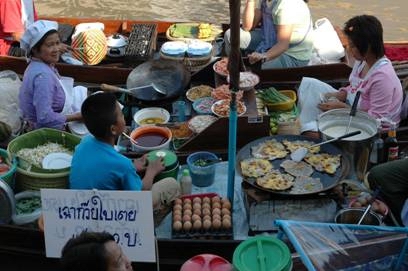
Bangkok Shopping Culture/ Community Regeneration: A case study of community-based tourism development in two water-based communities, Thailand
Sake Sawasdee, Niramon Piadaeng
Zeit: 31.05.2006, 18:30 Uhr
Ort: Technische Universität Wien Hörsaal 14a, Stg. 3, 3. Stock Karlsplatz 13 1040 Wien
Sake Sawasdee
Department of Interior Architecture, Faculty of Architecture, Chulalongkorn University
In 1785, Bangkok was given its longest name “Krungthep Mahanakhon Amornratanakosin Mahinthara Ayutthaya Mahadilok Phopnoppharat Ratchathani Burirom Udomratchaniwet Mahasathan Amornphiman Awatanasathit Sakkathathiya Witsanukamprasit” [“City of Angels, Built by Vishnukarma, Architect of Indra.”]
In the modern age, the 200 years old capital city is more exciting than ever, with its unbelievable Asian touch, cosmopolitan character and a never-ending shopping place for the visitor. Bangkok has been rightly called a shopper’s paradise. In 2006, the grand opening of Siam paragon has revolutionized the Bangkok shopping experience. As one of the most visited destinations in Thailand and the biggest shopping mall in Asia. With consumer demand rising, multinational Hypermarkets and Department stores try to serve, profit, and face the world class shopping culture. How does the growth of the shopping culture match with Thai Culture
Vortragende:
Niramon Piadaeng
Faculty of Architecture
Chulalongkorn University, Bangkok
am 31. Mai 2006 um 18:30 Uhr
Technische Universität Wien
Hörsaal 14a, Stg. 3, 3. Stock
Karlsplatz 13 1040 Wien
Community Regeneration: A case study of community-based tourism development in two water-based communities, Thailand
Niramon Piadaeng
Dept. of Urban and Regional Planning, Faculty of Architecture, Chulalongkorn University
The study explores the concept of community-based tourism development (CBT) as a viable tool for the sustainable development for communities in Thailand. CBT is defined as small-scale, gradual growth tourism with a high degree of community participation in its development process. Two water-based communities, Amphawa community in Samut Songkhram province and Ko Yao Noi community in Krabi province, are chosen as case studies. It is found that in there is high level of community participation in the CBT development process. Furthermore, CBT results in (1) broad-based distribution of economic benefits to community residents; (2) the conservation of tourism resource; (3) improvement of quality of life; and (4) building of local capacities for tourism management. However, recent challenges on developing CBT can be discerned as the entering of outside investor and the changing tourist group. In order to ensure the desirable conditions will endure over time, top-down interventions may be necessary in certain areas, such as the development and enforcement of environmental codes, in addition to the systematic empowerment of community residents and authority at the local level.

